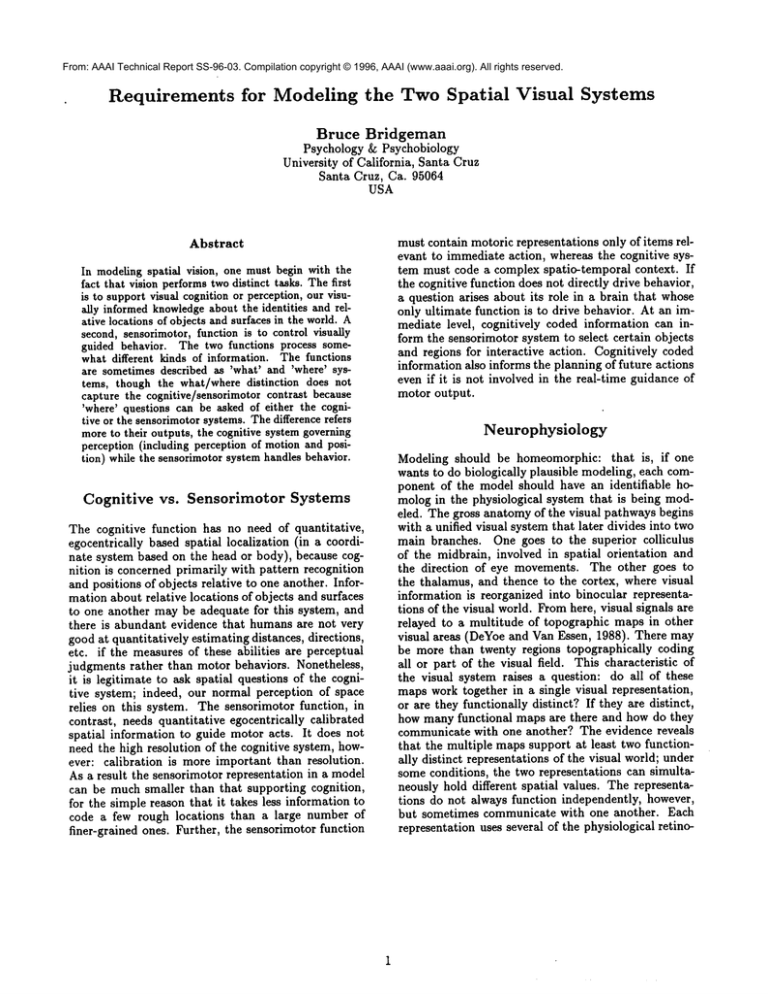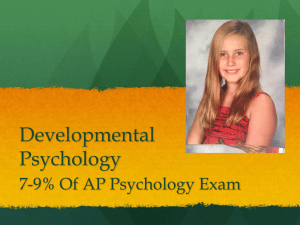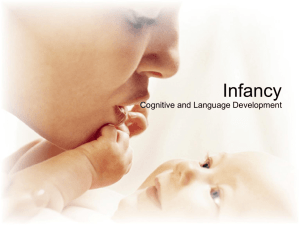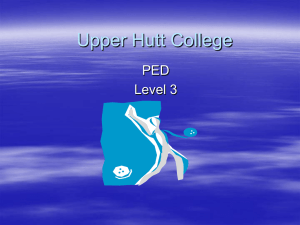Requirements for Modeling the Two Spatial Visual Systems
advertisement

From: AAAI Technical Report SS-96-03. Compilation copyright © 1996, AAAI (www.aaai.org). All rights reserved. Requirements for Modeling the Two Spatial Visual Systems Bruce Bridgeman Psychology & Psychobiology University of California, Santa Cruz Santa Cruz, Ca. 95064 USA Abstract In modelingspatial vision, one must begin with the fact that vision performstwodistinct tasks. The first is to support visual cognition or perception, our visually informedknowledgeabout the identities and relative locations of objects and surfaces in the world. A second, sensorimotor, function is to control visually guided behavior. The two functions process somewhat different kinds of information. The functions are sometimesdescribed as ’what’ and ’where’ systems, though the what/where distinction does not capture the cognitive/sensorimotor contrast because ’where’ questions can be asked of either the cognitive or the sensorimotorsystems. Thedifference refers moreto their outputs, the cognitive system governing perception (including perception of motion and position) while the sensorimotor systemhandles behavior. Cognitive vs. Sensorimotor Systems The cognitive function has no need of quantitative, egocentrically based spatial localization (in a coordinate system based on the head or body), because cognition is concerned primarily with pattern recognition and positions of objects relative to one another. Information about relative locations of objects and surfaces to one another may be adequate for this system, and there is abundant evidence that humans are not very good at quantitatively estimating distances, directions, etc. if the measures of these abilities are perceptual judgments rather than motor behaviors. Nonetheless, it is legitimate to ask spatial questions of the cognitive system; indeed, our normal perception of space relies on this system. The sensorimotor function, in contrast, needs quantitative egocentrically calibrated spatial information to guide motor acts. It does not need the high resolution of the cognitive system, however: calibration is more important than resolution. As a result the sensorimotor representation in a model can be much smaller than that supporting cognition, for the simple reason that it takes less information to code a few rough locations than a large number of finer-grained ones. Further, the sensorimotor function must contain motoric representations only of items relevant to immediate action, whereas the cognitive system must code a complex spatio-temporal context. If the cognitive function does not directly drive behavior, a question arises about its role in a brain that whose only ultimate function is to drive behavior. At an immediate level, cognitively coded information can inform the sensorimotor system to select certain objects and regions for interactive action. Cognitively coded information also informs the planning of future actions even if it is not involved in the real-time guidance of motor output. Neurophysiology Modeling should be homeomorphic: that is, if one wants to do biologically plausible modeling, each component of the model should have an identifiable homolog in the physiological system that is being modeled. The gross anatomy of the visual pathways begins with a unified visual system that later divides into two main branches. One goes to the superior colliculus of the midbrain, involved in spatial orientation and the direction of eye movements. The other goes to the thalamus, and thence to the cortex, where visual information is reorganized into binocular representations of the visual world. Fromhere, visual signals are relayed to a multitude of topographic maps in other visual areas (DeYoe and Van Essen, 1988). There may be more than twenty regions topographically coding all or part of the visual field. This characteristic of the visual system raises a question: do all of these maps work together in a single visual representation, or are they functionally distinct? If they are distinct, how many functional maps are there and how do they communicate with one another? The evidence reveals that the multiple maps support at least two functionally distinct representations of the visual world; under some conditions, the two representations can simultaneously hold different spatial values. The representations do not always function independently, however, but sometimes communicate with one another. Each representation uses several of the physiological retino- topicmaps;thecognitive andsensorimotor represen- limited to the parietal cortex, a relatively high-order tationsmay correspond respectively to pathways in structure that is well differentiated only in primates. thetemporal andparietal cortex respectively (Mishkin, Somefeatures of midbrain mechanisms, such as their Ungerleider and Macko,1983).The temporal pathway broad intermodal integration, are consistent with their consists of a numberof regions in whichneurons genpossible role in sensorimotor vision, and mayhave been erallyrespond to stimuli in larger andlarger regions more important in primitive mammals. Several lines of thevisual field, butrequire moreandmorespecific of research support this or related models of multiple features or properties to excitethem.Thisprocessrepresentations of visual space. Livingstone (1990) disingpathway culminates in theinferotemporal cortex, tinguishes a fast magnocellular system that is sensitive whichseemsto specialize in pattern recognition probto fast motion but is not color-sensitive, and a slower lemsinvolving choices anddiscriminations (Pribram, but higher acuity parvocellular system that supports 1971). Neurons in thisregion typically respond to very color. The temporal image-processing branch receives large areas ofthevisual field, usually including thefixboth kinds of input, while the parietal branch receives ’ ationpoint,andtheirresponses arehighlymodified only magnocellular input. Since most mammalshave by visualexperience andby thenatureof thevisual only a magnocellular system, the implication is that taskcurrently beingexecuted. Theparietal pathway, the parvocellular branch evolved to enhance pattern in contrast, specializes in physical features of thevirecognition in primates but plays no essential role in sualworld,suchas motionand location. One area parietal spatial orientation. contains a mapofthecortex thatspecializes in motion of objects, whileotherscontain neurons thatrespond Clinical Dissociation of Two Visual bothto characterics of thevisual worldandtointended Systems movements. The sensorimotor branchcan be further subdivided intotwoprocessing pathways thatprobably reflect twodifferent modesof spatial coding. Receptive The earliest evidence for separation of cognitive and sensorimotor functions came from neurological pafields ofneurons inthelateral intraparietal areaare tients. Damageto a part of the primary visual cortex spatially corrected before eachrapideyemovement, so thattheyrespond to stimuli thatwillbein their retino- results in an effective blindness in the affected field a scotoma. Patients have no visual experience in the topicreceptive fields (i.e.in retinally basedcoordiscotoma, and do not recognize objects or surfaces in nates)following a plannedeye movement(Duhamel, that area. But when forced to point to targets located Colbyand Goldberg1992).A secondcodingscheme in the scotoma, which they insist they cannot see, they is seenin another parietal cortexarea,7a.Neurons point accurately by using visuomotor information unin thisareaprovide information thatissufficient to reconstruct spatial position in head-centered coordinates available to their perception. This is an example of visually guided behavior without experience: the ob(Andersen, EssickandSiegel1985).Theresponses server cannot describe the visual world verbally, and theseneurons dependon botheyeposition in theorbitandretinal location of a target, ina multiplicativehas no verbal memoryof it. Visual information coexisting with a lack of visual experience is called blindinteraction. No singleneuronresponds to targets at sight (Weiskrantz, Warrington, Sanders, and Marshall, a constant location in space,butwithintheretino1974). It may be made possible by a pathway from the topicmapof theareainformation is available about retina to other parts of the visual cortex through the thehead-centered location of a target. Later, simulasuperior colliculus or other subcortical structures. Altionsshowed thatinformation sufficient toderive spaternatively, it may be mediated by remaining bits of tiotopic output exists in sucha network of cells (Zipser visual cortex, large enough to code positions but not andAndersen, 1988).A parallel distributed processing large enoughto allow visual experience. At first it was network couldbe trained to makeresponses to targets thought that blindsight allowed only gross localization at particular locations ina visual field. Aftertrainof objects, but more recent work has shown surprising,theresponse properties of thenodesin themodel ingly sophisticated processing without awareness, inturned outto beara striking resemblance to therecepcluding orientation and color discriminations (Cowey tivefields of theneurons inarea7a.Thefunctional reand Stoerig, 1991). Another example of dissociation of lation of thesetwospatial codingschemes is unknown. visuomotor and perceptual function has been found in Thearea7a neurons, however, possess theinformation a patient with damageto the lateral occipital and ocneededto perform the eyemovement-related correctingofreceptive field positions in thelateral intrapari- cipitoparietal regions of the cortex (Goodale and Miletalarea.If7a neurons inform thelateral intraparietal her, 1992). Whenasked to match line orientations, the patient showedgross errors such as judging horizontal neurons, theremapping couldbe performed in a sinto be vertical, though she had no scotoma in which viglesynaptic layer. Onlyspecific point-to-point connecsual experience was altogether absent. Whenasked to tions fromlateral intraparietal to7aneurons inthecorput a card through a slot at varying orientations, howresponding topographic locations wouldbe required. ever, she oriented the card correctly even as she raised Spatial processing maybe toobasica function to be her hand from the start position. There was a dissoci- ation between her ability to perceive object orientation and her ability to direct accurate reaching movements towards objects of varying orientations. Her cognitive representation of space was unavailable, while her visuomotor representation remained intact. The complementary dissociation, with retention of perception accompaniedby loss of motor coordination, is seen clinically under the label of ataxia. The neurological machinery that probably underlies this motor orienting ability has been described in the posterior parietal cortex of the monkey(Taira, Mine, Georgopoulos, Murata and Sakata, 1990). Neurons in this area respond during manipulation of objects by the hand in the light and in the dark. Most of them are also influenced by a visual stimulus, and some were selective in the axis of orientation of the object, suggesting that the neurons are concerned with visual guidance of hand movement, especially in matching the pattern of movementwith the spatial characteristics of the object to be manipulated. Such examples demonstrate separate cognitive and sensorimotor representations, but all of the demonstrations in humansare in patients with brain damage. Whena human suffers brain damage with partial loss of visual function, there is always the possibility that the visual system will reorganize itself, isolating fragments of the machinery that normally function as a unit. The clinical examples, then, leave open the possibility that the system mayfunction differently in intact humans. Rigorous proof that normal visual function also makes the cognitive/sensorimotor distinction must use psychophysical techniques in intact humans. Experimental Evidence in Normal Humans Some of the earliest evidence for a cognitive/sensorimotor distinction in normal subjects came from studies of perceptual and motor events surrounding rapid (saccadic) eye movements. Subjects are unaware of sizable displacements of the visual world if the displacements occur during saccadic eye movements. This implies that information about spatial location is degraded during saccades. There is a seeming paradox to this degradation, however, for people do not becomedisoriented after saccades, implying that spatial information is maintained. Experimental evidence supports the conclusion that perceptual and motor streams of information are segregated. For instance, the eyes can saccade accurately to a target that is flashed (and mislocalized) during an earlier saccade. Neuronsin the lateral intraparietal area, described above (Duhamelet al., 1992), might support such a capability. And hand-eye coordination remains fairly accurate following saccades. Howcan the perceptual information be lost while visually guided behavior is preserved? Resolution of this paradox begins with the realization that the conflicting observations use different response measures. The displacement experiments require a symbolic response, such as a verbal report or a button press. The behavior has an arbitrary spatial relationship to the target. Successful orienting of the eye or hand, in contrast, requires quantitative spatial information, defined as requiring a 1:1 correspondence between a target position and a motor behavior, such as directing the hand or the eyes to the target. The conflict might be resolved if the two types of report, which can be labeled as cognitive and sensorimotor, could be combined in a single experiment. If two pathways in the visual system process different kinds of information, spatially oriented motor activities might have access to accurate position information even when that information is unavailable at a cognitive level that mediates symbolic decisions such as button pressing or verbal response. The two conflicting observations (saccadic suppression on one hand and accurate motor behavior on the other) were combined by asking subjects to point to a target that had been displaced and then extinguished (reviewed in Bridgeman, 1992). On some trials a jump was detected, while on others the jump went undetected due to a simultaneous saccadic eye movement. As one would expect, subjects could point accurately to the position of the now-extinguished target following a detected displacement. Pointing was equally good, however, following an undetected displacement. It appeared that some information was available to the motor system even when it was unavailable to perception. One can also interpret the result in terms of signal detection theory as a high response criterion for the report of displacement. The first control for this possibility was a 2-alternative forced-choice measure of saccadic suppression of displacement, with the finding that even this criterion-free measure showed no information about displacement to be available to the cognitive system under conditions where pointing was affected (Bridgeman and Stark, 1979). The information was available to a motor system controlling pointing, but not to a cognitive system informing visual perception. Dissociation of cognitive and sensorimotor function has also been demonstrated for the oculomotor system, by creating conditions in which cognitive and sensorimotor systems receive opposite signals at the same time. This is a more rigorous way to separate cognitive and sensorimotor systems. A signal was inserted selectively into the cognitive system with stroboscopic induced motion. In this illusion a surrounding frame is displaced, creating the illusion that a target jumps although it remains fixed relative to the subject. Weknow that induced motion affects the cognitive system, because we experience the effect and subjects can make verbal judgments of it. But the above experiments implied that the information used for motor behavior might come from sources unavailable to perception. The experiment involved stroboscopic induced motion; a target spot jumped in the same direction as a frame, but not far enough to cancel the induced motion. The spot still appeared to jump in the direction opposite the frame, while it actually jumpedin the same direction. At this point, the retinal position of the target was stabilized by feedback from an eye tracker, so that retinal error could not drive eye movements. Saccadic eye movementsfollowed the actual direction, even though subjects perceived stroboscopic motion in the opposite direction (Wongand Mack, 1981). If a delay in responding was required, however, eye movements followed the perceptual illusion. This implies that the sensorimotor system has only a limited working memory, and must rely on information from the cognitive system when responding to targets that have disappeared. The sensorimotor system’s working memorywould hold quantitative, body-referenced spatial information, but only long enough to perform the next movement.In parallel with these distinctions between perceptual and motororiented systems, there is also behavioral evidence that extraretinal signals are used differently for movement discrimination and for egocentric localization: during pursuit tracking, Honda(1990) found systematic errors in perceptually judged distance of target movement, even while egocentric localization was not affected by the modeof eye movements.All of these techniques involve motion or displacement, leaving open the possibility that the dissociations are associated in someway with motion systems rather than with representation of visual location per se. Motion and location may be confounded in some kinds of visual coding schemes. A newer design allows the examination of visual context in a situation where there is no motion or displacement at any time (Bridgeman, 1992). The design is based the Koelofs effect (Roelofs, 1935), a perceptual illusion seen when a static frame is presented asymmetrically to the left or the right of a subject’s centerline. Objects that lie within the frame tend to be mislocated in the direction opposite to the offset of the frame. For example, in an otherwise featureless field, a rectangle is presented to the subject’s left. Both the rectangle and stimuli within it will tend to be localized too far to the right. All subjects reveal a Roelofs effect for a perceptual measure, judging targets to be further to the right whena frame is on the left and vice versa. But only half of them showthe effect for pointing - the rest remain uninfluenced by frame position in pointing. If a delay in responding caused some subjects to switch from using motor information directly to using information imported from the cognitive representation, delaying the response should force all subjects to switch to using cognitive information. By delaying the response cue long enough, all subjects showed a Roelofs effect in pointing as well as judging. Thus, like Wongand Mack’s induced motion experiments reviewed above, this design showed a switch from motor to cognitive information in directing the motor response, revealed by the appearance of a cognitive illusion after a delay. The sensorimotor branch of the system seems to hold spatial information just long enough to direct current motor activity, and no longer. The general conclusion is that information about egocentric spatial location is available to the visual system even when cognitive illusions of location are present. Egocentric localization information is available to the sensorimotor system even while the cognitive system, relying on relative motion and relative position information, holds unreliable information about location. Normally, the two systems work together because they operate accurately in parallel on the same visual world - it is only in the laboratory that the two can be separated, and can be seen to code the visual world with distinct algorithms. Toward a Two-systems Model of Visual Function The two systems can be modeled with a commoninput from early vision, followed by a division of processing streams to cognitive and sensorimotor branches. In a homeomorphcmodel, the division occurs after primary visual cortex, at least four synapses from the input. Each branch has its own independent map of visual space. Efference copy has its effect primarily in the sensorimotor branch, while calibration in the cognitive branch must be accomplished by relative positions of visual objects. The two branches affect behavior through independent noise sources. The sensorimotor branch has no access to memory.Therefore, if behavior is to be directed toward an object no longer present, visual information must be imported from the cognitive branch. In the process, any cognitive illusions of spatial localization are imported along with the information. These illusions are caused by the necessity to code localization in object-relative rather than egocentric terms in the cognitive branch. The process has been modeled by Dominey and Arbib (1992). A property of this model is that a topography of eye movement direction and amplitude is preserved through multiple projections between brain regions until they are finally transformed into a temporal pattern of activity that drives the eyes to their target. Control of voluntary eye movements to visual and remembered targets is modeled in terms of interactions between posterior parietal cortex, frontal eye fields, the basal ganglia (caudate and substantia nigra), superior colliculus, mediodorsal thalamus, and the saccade generator of the bralnstem. A more complete model will have to include the cognitive branch as well. Challenges for the Future The cognitive and sensorimotor systems described here are not strictly independent, and the precise nature of their communications with one another remains a topic for future research. There is enough physiological data in this area that future models can be usefully constrained by the knownstructure of connections in the visual areas of the brain. Modelsthat are inconsistent with this architecture maybe interesting intellectually or of practical value for robotic control, but maynot reflect visual spatial processing as instantiated in the brain. One of the important areas to be worked out is the issue of frames of reference - sensorimotor action must occur in a body-centered (egocentric) frame, while cognitive coding can be either in an egocentric or a world-centered frame. Our perception of space constancy, the apparent stability of the visual world as our receptors movearound in it, suggests that a worldcentered frame is central to cognitive processing, but the known neural maps of the world are retinotopically based, especially in the temporal-lobe branch of the visual system where cognitive processing probably is supported. Receptive fields in locations such as inferotemporal cortex can be very large, usually including the fovea, but they do not support space constancy at the single-neuron level. If reference frames are re-established with each eye fixation (Bridgeman, van der Heijden and Velichkovsky, 1994), no correction of axes is necessary. At the beginning of each new fixation the visual system uses whatever retinal and extraretinal information is available to establish a calibration, without regard to the information from previous fixations. To the degree that the information in the current fixation is accurate, the calibration will happen to be consistent with the calibrations for previous fixations, even without a comparison between successive fixations. Errors or inconsistencies in calibration from one fixation to the next are normally not perceived, unless they are very large. This contrasts with the situation in the sensory motor system, where perception of constancy is not an issue, but motorically necessary calibrations must be maintained. These calibrations mayinclude joint-centered processing to allow real-time control of skilled movements. References Bridgeman, B., 1992, Conscious vs unconscious processes: the case of vision. Theory & Psychology, 2:7388. Bridgeman, B., and Stark, L., 1979, Omnidirectional increase in threshold for image shifts during saccadic eye movements, Perception & Psychophysics, 25: 241243. Bridgeman, B., van der Heijden, L., and Velichkovsky, B., 1994, A Theory of Visual Stability Across Saccadic Eye Movements,Behavioral and Brain Sciences, 17:247-292. Cowey, A, and Stoerig, P., 1991, The neurobiology of blindsight. Trends in Neurosciences, 14:140-145. DeYoe, E.A., and Van Essen, D.C., 1988, Concurrent processing streams in monkeyvisual cortex, Trends in Neuroscience, 11:219-226. Dominey, P., and Arbib M. A., 1992, A corticosubcortical model for generation of spatially accurate sequential saccades. Cerebral Cortex, 2:153-175. DuhamelJ., Colby C., and Goldberg M., 1992, The updating of the representation of visual space in parietal cortex by intended eye movements, Science, 255:90-92. Goodale M. A., and Milner A. D., 1992, Separate visual pathways for perception and action, Trends in Neurosciences, 15:20-25. Livingstone, M., 1990, Segregation of form, color, movement, and depth processing in the visual system: anatomy, physiology, art, and illusion. In B. Cohen & I. Bodis-Wollner (Eds.), Vision and the brain: the organization of the central visual system, (pp. 119-138). NewYork: Raven Press. Mishkin, M., Ungerleider, L., and Macko, K., 1983, Object vision and spatial vision: Twocortical pathways, Trends in Neurosciences, 6:414-417. Paillard, J., 1987, Cognitive versus sensorimotor encoding of spatial information, in Cognitive Processes and Spatial Orientation in Animal and Man. (P. Ellen and C. Thinus-Blanc, Eds.), Dordrecht, Netherlands: Martinus Nijhoff Publishers. Roelofs, C., 1935, Optische Localization. Archives fr Augenheilkunde, 109:395-415. Weiskrantz, L., Warrington, E., Sanders, M., and Marshall, J., 1974, Visual capacity in the hemianopicfield following a restricted occipital ablation, Brain, 97:709728. Wong, E., and Mack, A., 1981, Saccadic programming and perceived location, Acta Psychologica, 48:123-131. Zipser, J. and Andersen, R. A., 1988,. A backpropogation programmed network that simulates response properties of a subset of posterior parietal neurons. Nature, 33:679-684.





